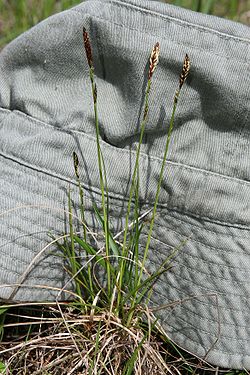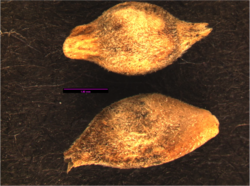Carex inops
Carex inops, Cyperaceae,Long-stolon sedge, Sun sedge, Dry-land sedge
Contents
Taxonomy
- Kingdom: Plantae
- Subkingdom (unranked): Tracheobionta
- Superdivision (unranked): Spermatophyta
- Division: Magnoliophyta
- Class: Liliopsida
- Subclass (unranked): Commelinidae
- Order: Cyperales
- Family: Cyperaceae
- Genus: Carex L.
- Species: C. inops L.H. Bailey
Description
Long-stolon sedge is a loosely caespitose, perennial graminoid. It is low to medium statured compared to other Carex. Culms are 4 to 20 inches (10-50 cm) long. Leaves are slender, stiff, and wiry. Old, dead leaves are persistent, often forming fibrous tufts at the stem base. Inflorescences are terminal staminate and pistillate spikes. Male spikes may be pediceled above female spikes. The fruit is a hairy achene ranging from 1.6 to 2.5 mm long. Seedheads bear 5 to 15 fruits each.
Bloom Period
Distribution
Found in the northwestern Great Plains of the United States and Canada, ranging from the western Dakotas to Montana and Saskatchewan.
Habitat
Ecological Setting-Stands are found on gently rolling uplands with little to moderate slope. Soil Texture-Stands occur on substrates with a significant component of sand, sandy loams or just sands, of colluvial or aeolian origin. Nutrients-Nitrogen-medium Moisture Regime Moisture levels may be high and deep in the profile. Shade Tolerance Shade intolerant Successional Status-occurs and may be common in all stages of grassland succession
Uses
Wildlife: Rodents, lagomorphs, and ungulates graze sun sedge. On the Pawnee National Grassland, Ord's kangaroo rats, northern grasshopper mice, thirteen-lined ground squirrels, and deer mice utilization of sun sedge ranged from 0.1% to 5.0% across 1 year. Seasonal utilization was not given. Sun sedge was an important component of the spring and early summer diets of black-tailed jackrabbits on the Pawnee National Grassland. In Wind Cave National Park, elk use of sun sedge was similar from winter to summer (3.7-5.0%) and least in fall (0.9%). Sun sedge was a minor component of the pronghorn diet on the Pawnee National Grassland. Use peaked at 4% in April and May, with only trace amounts consumed in other months. Sun sedge was also a minor component in the pronghorn diet (17% frequency but 1%-4% utilization) in a needle-and-thread grass-western wheatgrass community in southeastern Alberta. On the Pawnee National Grasslands, bison grazed sun sedge in trace amounts in December and did not utilize it in other months.
First Nations: Used by Navajo as a gastrointestinal aid and to help fight infections.
Propagation
Long-stolon sedge is wind pollinated. Little is known of either sun sedge's ability to establish from seed or its growth rate.
Seed
Abbreviation: CAIN
Seed sample from: 2010
Average measurement: 3.6 x1.6 x 1.3
Measurement Range: L: 2.5 – 4.5, W: 1.2 – 2, D: 1 – 1.9
Features
Shape: Seeds narrow at hilum and opposite apex, rounded in middle. Opposite apex usually sharply pointed. Seed sometimes has bits of husk still attached. Hilum circular.
Color: Tan with some darker brown or black spotting. Hilum usually brown.
Surface: Some concave patches, entire seed covered in fine hair, and matte.
Latitudinal Cross Section: elliptical 
Longitudinal Cross Section: elliptical ![]()
Basic Explanations and Assumptions:
The dimensions for the seeds are length x width x depth. The location of the hilum is used as the base of the seed, and the length is measured from hilum to the opposite apex. Where a style is present, the length is measured from the hilum to the bottom of the style. Width is measured at a right angle to the length at the widest part. Depth is measured at a right angle to the intersection of height and width lines.
Measurements included are the mean average for each measurement of ten separate seeds.
All measurements in millimeters unless otherwise noted.
Photo Gallery
References
[1]USDA http://biology.burke.washington.edu/herbarium/imagecollection.php http://www.fs.fed.us/database/feis/plants/graminoid/carino/all.html http://mtnhp.org/ecology/Guide_Report.asp?elcode=CEGL001471 http://biology.burke.washington.edu/herbarium/imagecollection/wtu27000-27499/lg/wtu027233_lg.jpg
http://linnet.geog.ubc.ca/Atlas/Atlas.aspx?sciname=Carex%20inops





